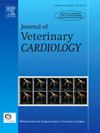健康猫和心肌病猫体重归一化左心房内径的临床应用。
IF 1.3
2区 农林科学
Q2 VETERINARY SCIENCES
引用次数: 0
摘要
简介/目的:猫的左心房尺寸与体重(BW)相关。心房尺寸可以从右胸骨旁长轴(RPLAx)和右胸骨旁短轴图像获得。然而,需要从大量健康猫样本中获得rplax衍生的左房内径(LAD)的参考范围。本研究从RPLAx视图测量LAD,并计算BW (LADn)和左心房直径与主动脉环比(LAD:Ao)的归一化值。研究目的包括制定LADn的预测区间,定义LAD:Ao的参考区间,并研究这些变量在检测患有心肌病的猫的充血性心力衰竭(CHF)时的有用截止点。动物、材料和方法:健康猫(n = 303)和不同类型心肌病猫(临床前猫198;CHF猫71)。根据RPLAx图像,测量从心房间隔到收缩期末游离壁的LAD,并在环处测量主动脉直径,计算LAD:Ao。采用线性回归分析研究体重对LAD的影响。生成了识别CHF猫的LADn和LAD:Ao的截止值。结果:LAD与BW相关(r = 0.52, P0.19),中位RPLAx LAD:Ao为2.0(95%参考区间:1.55 ~ 2.47)。LADn >12.7和LAD:Ao >2.5检测CHF的敏感性分别为92.8%和88.7%,特异性分别为91.5%和93.6%。研究局限性:由于研究的回顾性设计和缺乏纵向随访,不能完全排除将隐匿性CM猫纳入健康组。结论:猫的LAD与体重相关。在LA维度的评价中,LADn和LAD:Ao可能优于未调整的LAD,特别是在小型和大型猫品种中。本文章由计算机程序翻译,如有差异,请以英文原文为准。
Clinical utility of left atrial diameter normalized for body weight in healthy and cardiomyopathic cats
Introduction/Objectives
Left atrial dimensions correlate with body weight (BW) in cats. Atrial dimensions can be obtained from both right parasternal long-axis (RPLAx) and right parasternal short-axis images. However, reference ranges for RPLAx-derived left atrial diameter (LAD) obtained from a large sample of healthy cats are needed. This study measured LAD from the RPLAx view and calculated a normalized value to BW (LADn) and left atrial diameter-to-aortic annulus ratio (LAD:Ao). Study aims included developing prediction intervals for LADn, defining reference intervals for LAD:Ao, and investigating useful cutoffs for these variables for detection of congestive heart failure (CHF) in cats with cardiomyopathy.
Animals, Materials and Methods
Healthy cats (n = 303) and cats with different types of cardiomyopathy (198 preclinical; 71 with CHF). From RPLAx images, the LAD was measured from the interatrial septum to the free wall at end-systole and aortic diameter was measured at the annulus to calculate the LAD:Ao. Linear regression analysis was used to investigate the effect of BW on the LAD. Cutoffs of LADn and LAD:Ao that identified cats with CHF were generated.
Results
The LAD correlated to BW (r = 0.52, P<0.001). The formula to calculate LADn was LAD (mm)/BW (kg)0.19, while median RPLAx LAD:Ao was 2.0 (95% reference interval: 1.55–2.47). Values of LADn >12.7 and LAD:Ao >2.5 had a sensitivity of 92.8% and 88.7% and a specificity of 91.5% and 93.6%, respectively, in detecting CHF.
Study Limitations
Due to the retrospective design of the study and lack of longitudinal follow-up, the inclusion of cats with occult CM in the healthy group cannot be entirely ruled out.
Conclusions
The LAD correlates with BW in cats. In the evaluation of LA dimension, LADn and LAD:Ao might be preferable to unadjusted LAD, especially in smaller and larger breeds of cats.
求助全文
通过发布文献求助,成功后即可免费获取论文全文。
去求助
来源期刊

Journal of Veterinary Cardiology
VETERINARY SCIENCES-
CiteScore
2.50
自引率
25.00%
发文量
66
审稿时长
154 days
期刊介绍:
The mission of the Journal of Veterinary Cardiology is to publish peer-reviewed reports of the highest quality that promote greater understanding of cardiovascular disease, and enhance the health and well being of animals and humans. The Journal of Veterinary Cardiology publishes original contributions involving research and clinical practice that include prospective and retrospective studies, clinical trials, epidemiology, observational studies, and advances in applied and basic research.
The Journal invites submission of original manuscripts. Specific content areas of interest include heart failure, arrhythmias, congenital heart disease, cardiovascular medicine, surgery, hypertension, health outcomes research, diagnostic imaging, interventional techniques, genetics, molecular cardiology, and cardiovascular pathology, pharmacology, and toxicology.
 求助内容:
求助内容: 应助结果提醒方式:
应助结果提醒方式:


